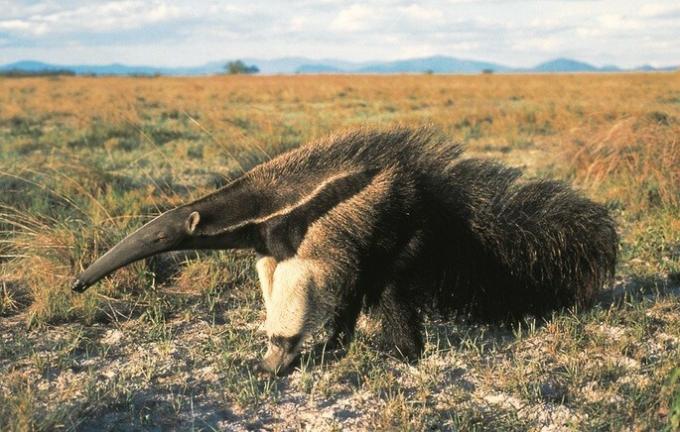Fauna is the group of animals in a given region. Flora is the representation of plant species.
When talking about Brazilian fauna and flora, all animals and plants that have their habitat in one of the existing biomes in Brazil are being referred to.
In Brazil, there are six large biomes: cerrado, caatinga, Atlantic forest, pampas, wetlands and the Amazon. In other words, each community has specific characteristics and its own biodiversity. Animals (fauna) and plants (flora) vary according to the environment in which they are found.
What is fauna?
Fauna represents the community of animal species that inhabit a specific or extended environment. Thus, the term can be used in relation to a specific biome, for example, fauna of the cerrado or, in general, as Brazilian or world fauna.
It can also have an even broader sense, relating to a period: for example, "fauna of the Jurassic period".
In other words, the representation of the collective of animals from a certain place or period is called fauna.
The Brazilian fauna, for example, is the most diverse in the world. In general, it is composed of small animals, many not yet cataloged by biologists.

There is a vast collection of vertebrate animals (mammals, birds, reptiles, amphibians and fish) and invertebrates (insects, molluscs, annelids, etc.) that make up the Brazilian fauna.
See too: Brazilian fauna.
What is flora?
Flora, unlike fauna, is the term used to refer to all species of vegetation in an ecosystem or period.
Brazil also has the greatest diversity of flora on the entire planet. More than 46 thousand plant species are catalogued, almost three thousand at risk of extinction.
The Brazilian flora also varies according to the region and biome in which they are found. The greatest examples of flora diversity in the country are found in the Amazon and the Atlantic Forest.
Brazil received this name in reference to an element of its flora, pau-brasil. The tree with a reddish (ember-colored) trunk was very common on the coast of the country and served as inspiration for the name given by the Portuguese.

See too: Flora of Brazil.
Brazilian fauna and flora
In Brazil, fauna and flora are divided among the six predominant biomes in the country. Some species of plants and animals are present in more than one biome, others, in turn, are specific to an ecosystem.
See the main characteristics of fauna and flora in Brazilian biomes:
Cerrado fauna and flora
- Cerrado fauna - More than 300,000 species of animals, including the giant anteater, the maned wolf, the gray eagle and the ocelot, both threatened with extinction.
- Cerrado flora - Undergrowth and sparse medium and small trees, with thick leaves and deep roots. About 4,000 species of plants existing in the cerrado are endemic, that is, they only develop in this location.
Fires and animal trafficking are obstacles to the preservation of the biome.
See too: Çwrong.
Caatinga fauna and flora
- Caatinga fauna - several species of mammals, lizards, fish and birds (such as the famous white wing sung by Luís Gonzaga).
- Caatinga flora - Resistant vegetation to the Brazilian semiarid soil. Some species have their own water reserve for dry periods. Several species of cactus, shrubs and undergrowth.
See too:Caatinga.
Pantanal fauna and flora
- Pantanal fauna - Reptiles, birds, mammals and fish. This makes the wetland one of the richest fauna on the planet.
- Pantanal flora - Vegetation, in general, coming from other biomes adapted to the few dry areas or wetlands and a great diversity of aquatic plant species.
See too: wetland.
Fauna and flora of the Pampas
- Fauna of the Pampas - Plains animals like some birds, deer, armadillos, etc.
- Flora of the Pampas - Few sparse trees and several species of grasses.
The pampas are at risk of disappearing due to the advance of agricultural production, above all, cattle raising.
See too: pampa.
Fauna and flora of the Atlantic Forest
- Atlantic Forest Fauna - Several species of small primates, felines
- Atlantic Forest Flora - Tropical forest that houses the greatest diversity of species per unit of area.
The Atlantic Forest preserves a series of animals and plants at risk of extinction, which suffer from fires, animal trafficking and urbanization processes.
See too: Atlantic forest.
Amazon fauna and flora
The Amazon is the largest Brazilian biome, it is also the one with the greatest biodiversity.
- Amazon fauna - Largest collection of animals on the planet, many not yet cataloged by researchers.
- Flora of the Amazon - Humid tropical forest, it contains one third of all plant species in South America.
The Amazon flora is the object of study by several organizations and has great potential due to the presence of numerous species of medicinal plants.
It is the largest rainforest in the world. Its protection and the fight against burning, deforestation and illegal logging are the focus of discussion between governments and conservation entities.
Interested? See too:
- Amazon rainforest
- Brazilian Biomes
- Biodiversity
- Logging
- burns

